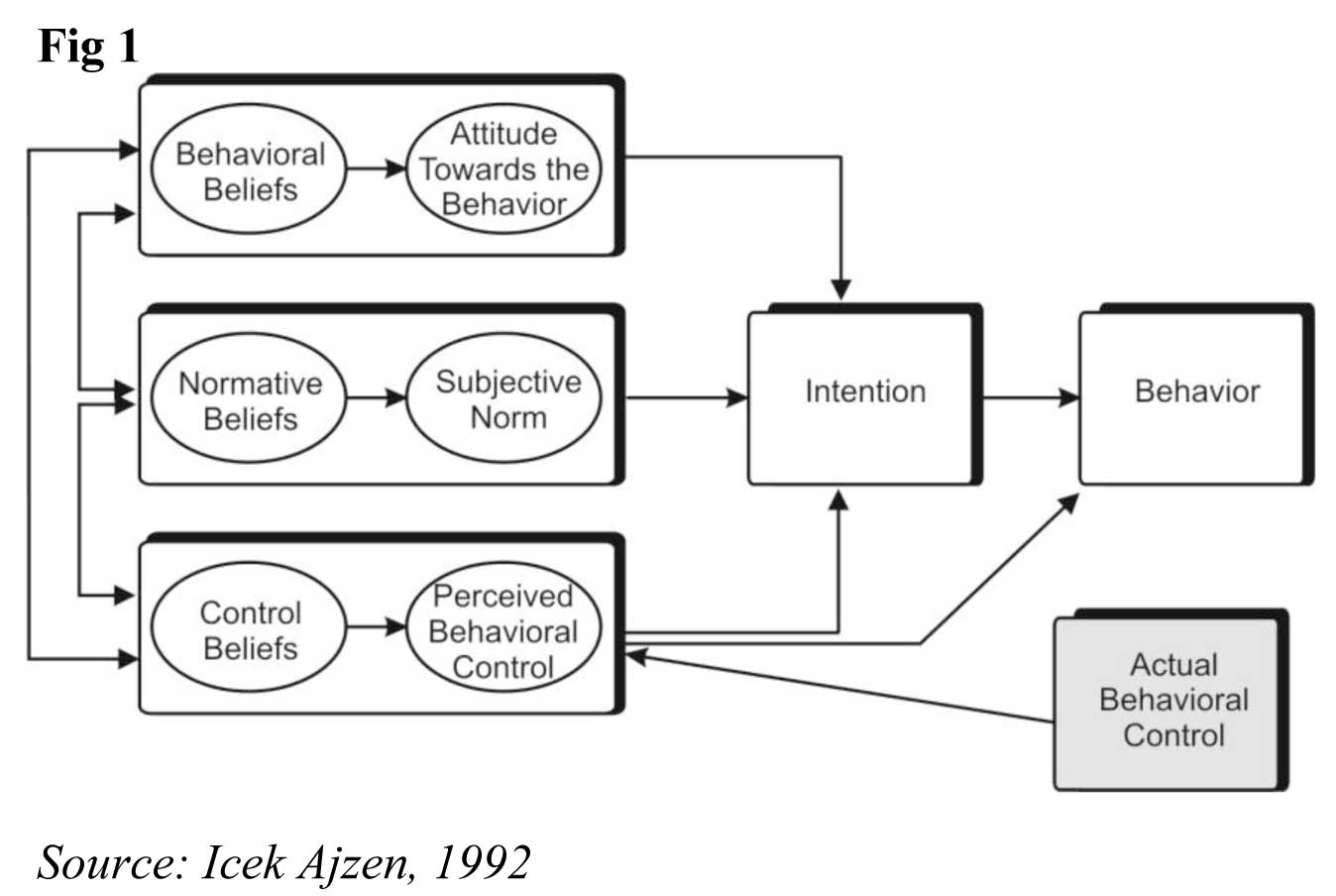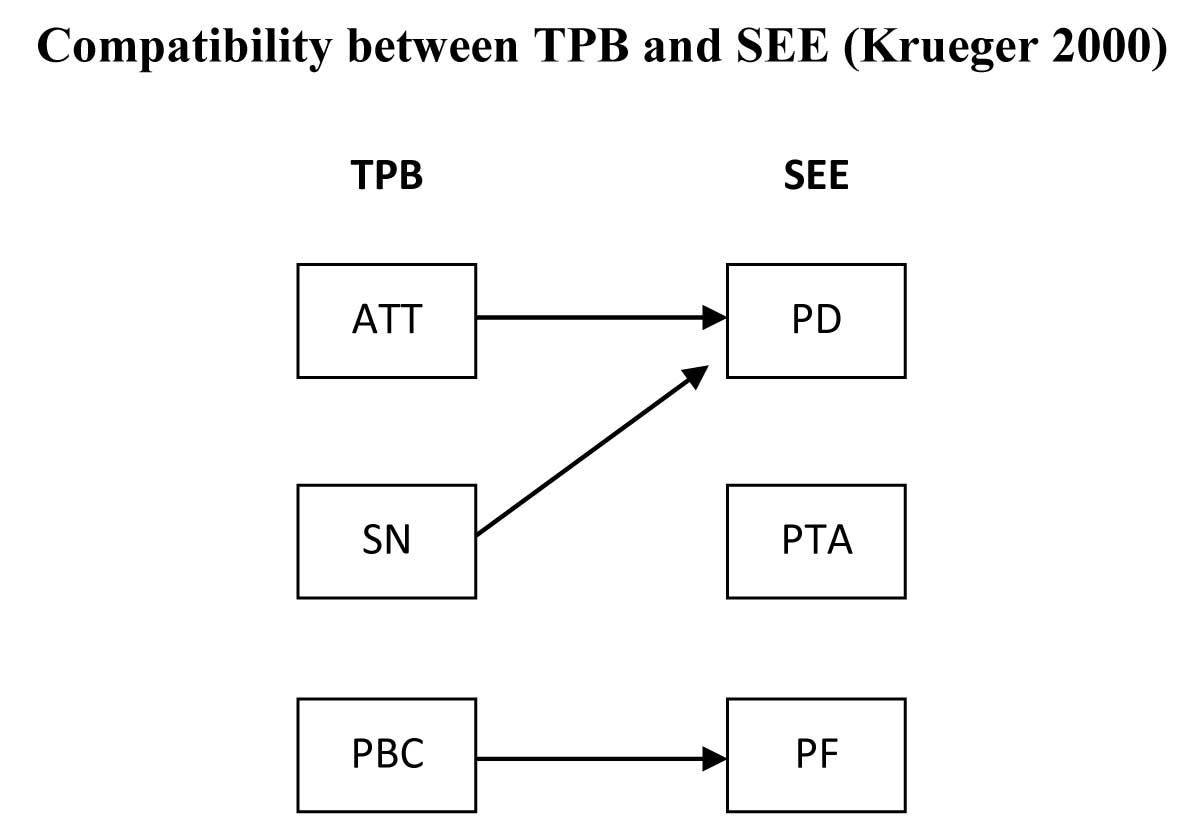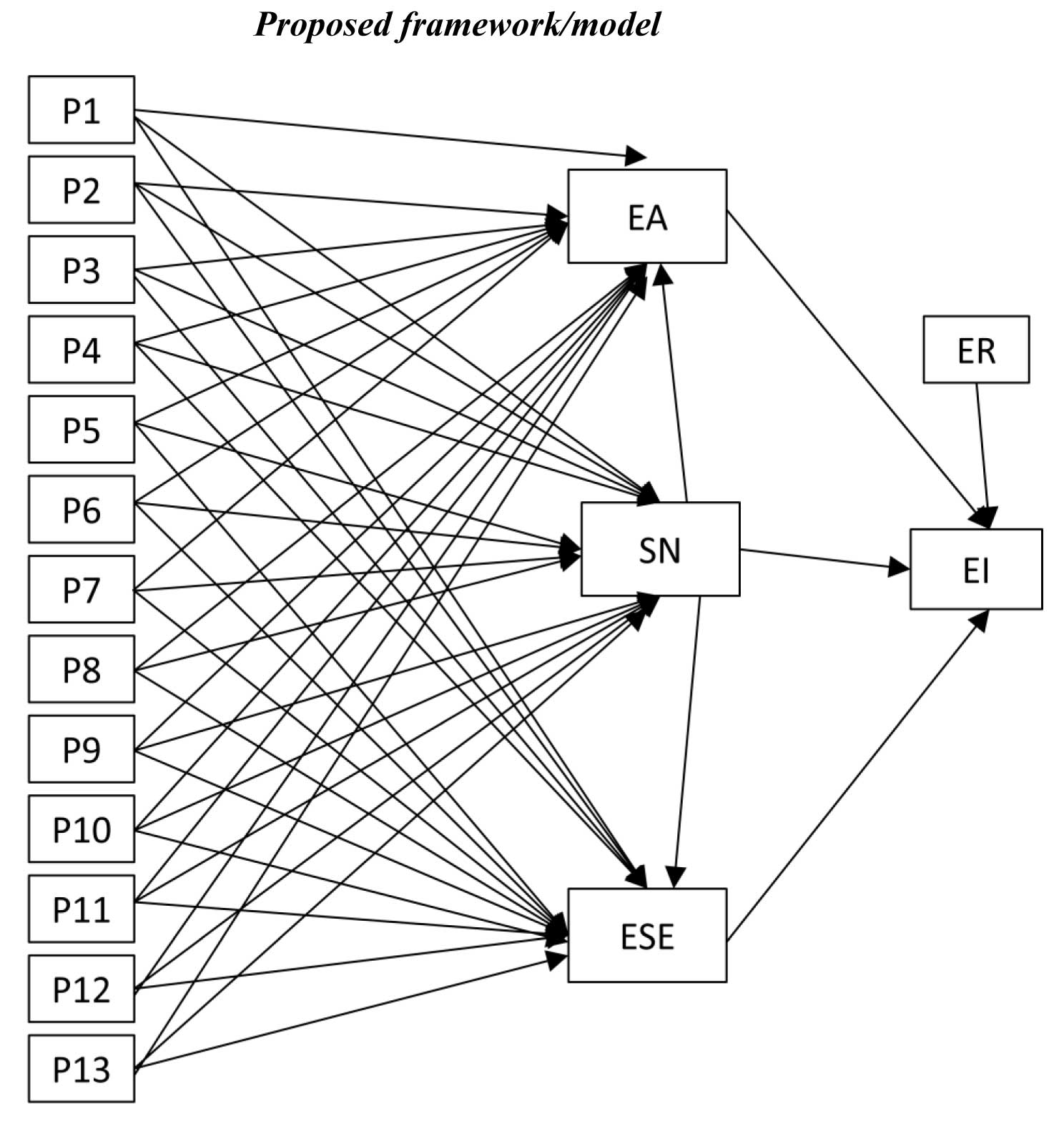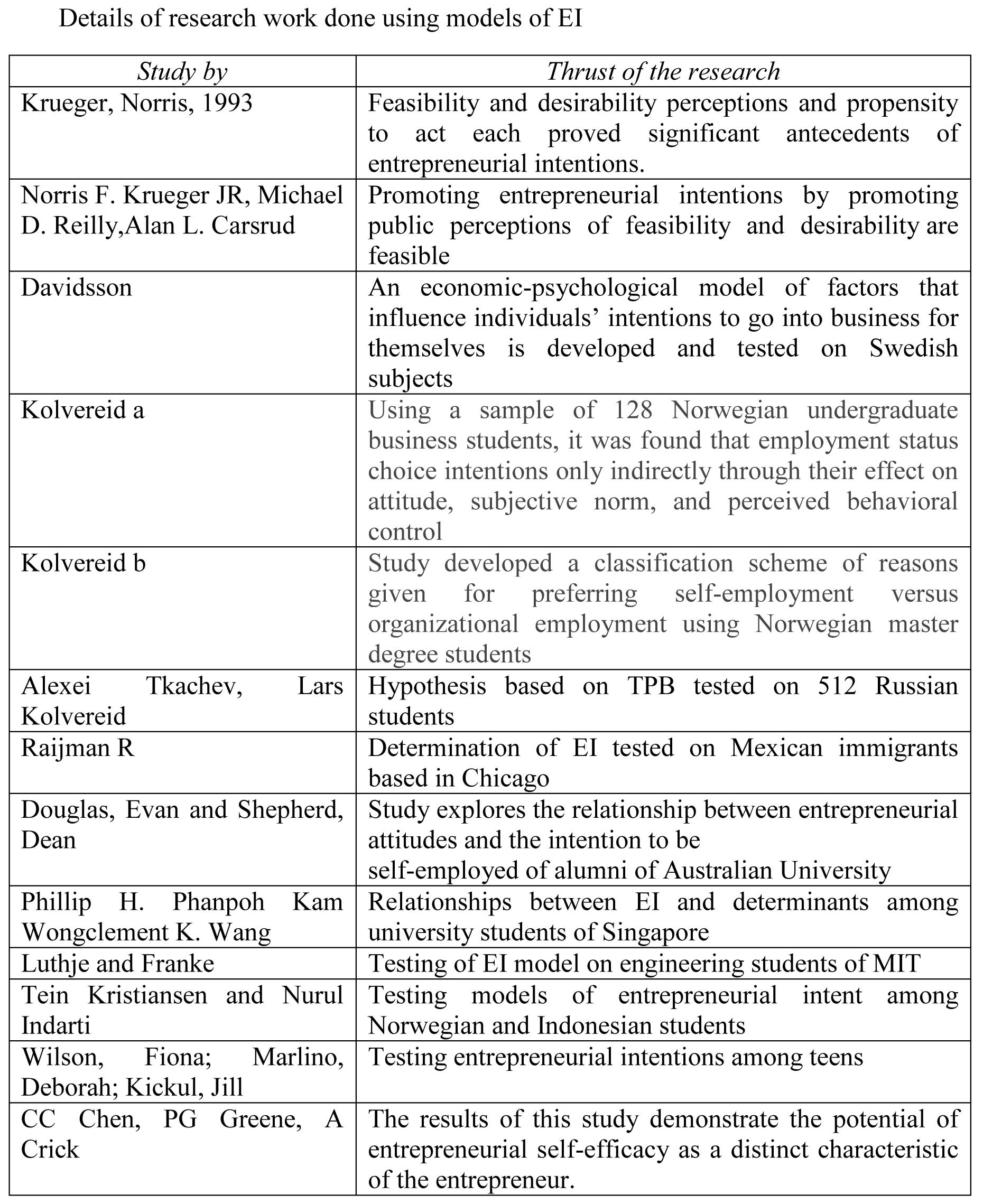Subscribe now to get notified about IU Jharkhand journal updates!
Addressing The Complex Issue Of Understanding Entrepreneurial Intentions Of Indian Millennials: Adopting A Intention-Driven, Theory-Based Model
Abstract :
The Millennials are considered the most entrepreneurial generation among the workforce. Given the unique traits and characteristics of this generation, understanding and predicting entrepreneurial intentions (EI) among Millennials will go a long way in facilitating new venture creation and start-up culture in the country. The Theory of Planned Behavior (TPB) that has been successfully applied to understanding consumer behavior can be applied to understand EI among Indian Millennials (Kolvereid). Shapero & Sokol's theory of the entrepreneurial event (SEE) is an intention-based model aiming to explain entrepreneurial intentions and better understand subsequent behavior.
Applying both the models of TPB and SEE to understand EIs of Indian Millennials requires a well-researched and contextual research design that includes all the elements impacting EI. This paper puts forth a research design using a conceptual framework/model containing the linkages between various mediating and independent variables and their subsequent impact on the dependent variable. The different parameters proposed to be used to understand EI have been carefully chosen after a diligent literature review. The research design is visualized keeping the tools used for collecting data from target respondents in mind.
Keywords :
Entrepreneurial intentions, Theory of planned behavior, Shapiro Entrepreneurial event, research design, conceptual frameworkIntroduction :
According to Schumpeter (1912) “entrepreneurs are individuals who exploit market opportunities through technical and/or organizational innovation”.
While enough has been written about the importance of Indian entrepreneurs and their contributions to the nation’s economy, concrete and
systematic research on entrepreneurial intentions is too few and far in-between. Research that throws light on the factors that promote or impede
the entrepreneurial aspirations of the Indian entrepreneur would go a long way in facilitating entrepreneurial activity in a big way.
Literature review reveals that EI was found to be impacted by factors like gender, education, having an entrepreneurial parent(s) or enterprise
(Crant, 1998), (JC Carr, 2007). There are a number of studies on education affecting students’ attitude towards entrepreneurship
(Basu and Virick, 2008). Studies have brought out the relation between entrepreneurial self-efficacy (ESE) and entrepreneurial intentions
(EI)(Shinnar, Hsu, Powell, 2014).The relationship between entrepreneurial self-efficacy, self-regulation and entrepreneurial intention using
Bandura’s structural path model has also been pursued ( Pihie, Z.A.L. & Bagheri, A, 2013). The statistically significant relationship between
personality attributes and entrepreneurial intentions has been reported by researchers (Ozaralli and Rivenburgh 2016). The influence of cultural
dimensions on entrepreneurs has been widely studied using the Hofstede Model (Ratsifandrihamanana, 2014; JR Fitzsimmons, 2005; Urban, 2008).
Study of entrepreneurial intentions (EIs) among Indian students revealed a number of factors that can have a significant impact (NC Bhandari,
2015). Part-time work experience and social network effects are found to be the strongest in shaping entrepreneurial intentions with equal impact
on both male and female genders (Noel Saraf, 2015). The impact of age and educational qualification on entrepreneurial intent has been studied in
Indian students (Arunkumar Velusamy, 2014).
However, demographic models have been found to have limited use in understanding EI. Similarly, personality traits are found to explain only 10%
of the variance in behavior (Ajzen, 1987). Models based on demographics, personality traits or attitudinal approaches have been found to less
predictive and are considered to be less robust approaches of studying EI (Tiurenkov, 2011).
Instead, it is proposed that entrepreneurial intentions (EI) be studied through the use of the intention model, which offers a coherent,
parsimonious and highly generalizable theoretical framework to predict intentions (Krueger, Reilly & Carsrud, 2000).
In the social psychology literature, intentions have proved to be the best predictor of planned individual behaviors, especially when the target
behavior is rare, difficult to observe, or involves unpredictable time lags (Krueger, Reilly, and Carsrud 2000). The entrepreneurial intention is
most often expressed studied antecedent of venture creation. This kind of approach draws on a well‐established body of literature linking
intention of subsequent actions (Ajzen, 1987, 1991) and has been proposed several times as the best predictor of entrepreneurial behavior
(Shapero, 1982; Honig, 2004). The present study incorporates the theories espoused by Ajzen and Shapero in the form of a conceptual framework to
study EIs of population samples.
Theory of Planned Behavior
Ajzen's Theory of Planned Behavior (TPB) is widely used in psychology to understand the behavior of individuals (Krueger, Carsrud, 1993). TPB and
its precursor, Theory of Reasoned Action focus on the theoretical constructs concerned with individual motivational factors as determinants of
the likelihood of performing specific behaviors (DE Montano, D Kasprzyk, 2015). Intentions to perform behaviors of different kinds can be
predicted with high accuracy from attitudes toward the behavior, subjective norms, and perceived behavioral control (J Cheon, S Lee, SM Crooks,
J Song,2012, CJ Armitage, 2001, Koe, 2012); and these intentions, together with perceptions of behavioral control, account for considerable
variance in actual behavior. Research works have demonstrated that the Ajzen’s framework is a solid model for explaining or predicting
entrepreneurial intentions (Kolvereid, 1992).
According to TPB, human action is guided by three kinds of considerations.
- Behavioral beliefs(beliefs about the likely consequences of the behavior)
- Normative beliefs (beliefs about normative expectations of others)
- Control beliefs (beliefs about the presence of factors that may facilitate/impede performance of the behavior)

Shapero’s Entrepreneurial Events (SEE)
Shapero's model assumes that inertia guides human behavior until something interrupts or displaces that inertia. Displacement can be negative or
positive. Displacement precipitates a change in behavior and the decision maker seeks the best opportunity available from her or his enacted set
of alternatives (Katz, 1992).The choice of the resulting behavior depends on the relative "credibility" of alternative behaviors (in this
situation to this decision maker) plus some "propensity to act" (without which the decision maker may not take any significant action).

Both models (Shapero and Ajzen) have been used in a large number of studies undertaken to study EI. The models have been used separately and
together with good results.


It is observed that both models show some degree of mutual compatibility. Both the TPB and SEE models provide comparable interpretations of
entrepreneurial intentions (Krueger, N.F., 1993; 2000). Krueger demonstrated that attitudes and subjective norms in the Theory of Planned
Behavior model are conceptually related to perceived desirability in SEE; while perceived behavioral control in TPB corresponds to perceived
feasibility in the SEE model. Essentially, perceived desirability and perceived feasibility are fundamental elements of intentional behavior.

(ATT=attitudes; SN= subjective norms; PBC= perceived behavior control; PD=Perceived desirability; PTA= propensity to act; PF= perceived
feasibility)
Taking the similarities into consideration, an integrated model containing the elements of both the models is being used in the present study.
This is done to avoid repetition and ambiguity. The model of entrepreneurial potential by Krueger and Brazeal (1994) is taken as a standard to
create a model suitable for use on the targeted populations.
The target population
Indian Millennials are the chosen target population for this research study. Millennials or Gen Y refers to that group of individuals born
between the year 1980 and year 2000(Hartman, McCambridge, 2011). Among the four generations (Silent Generation, Baby Boomers, Gen X and Gen Y)
understanding the factors that influence the entrepreneurial intentions of the millennials are considered to be the most significant (Koe et al,
2012).
The influencing factors of millennials across the globe vary from region to region and the contextual factors impacting Indian millennials need
to be understood.
Taking the case of the Indian context, post-liberalization leading to the opening up of markets after 1991 saw this group impacted by significant
cultural, socio-economic changes. All these factors culminated in creating characteristics in the Millennials like increasing demand for ethical behavior, accountability, and transparency.
Encouraging entrepreneurial intention among this generation would result in intense entrepreneurial activity in diverse geographic regions.
Proposed model
Based on the review of the literature and previously tested models the following framework/model was conceived by the researcher for the study
and is proposed to be used for the study of EI.

(EI=Entrepreneurial intentions; ER=entrepreneurial resistance; EA=entrepreneurial attitudes; SN=subjective norms; ESE=entrepreneurial self
efficacy; p1-13 different parameters for studying EA, SN and ESE)
The proposed model is based on a review of the literature to arrive at a pattern of association between the main variable EI and other dependent
variables. The model also reveals the relationship between the variables as shown in the schematic diagram. The influence of various factors on
the independent variable EI will be understood and analyzed through this model.
The various researches undertaken on different populations across the globe are used as a basis for the conception of this model. The details of
the researchers are given below in the table.

The proposed model is intended to study the impact of various parameters on EI of students in final year management and engineering. These
students are crucial for the study as they are about to embark on careers and will be making major decisions regarding their future career plan.
While EI is the dependent variable in the model, entrepreneurial attitude (EA), subjective norms (SN) and entrepreneurial self-efficacy (ESE)
will be the mediating variables (Koe et al, 2012). The impact of various parameters P1-P12 on EI will be mediated by these variables. Selection
of various parameters is based on literature review and the results of the pilot study conducted by the researcher. These parameters will act as
dependent variables in the study.
Factors impacting EI
Independent variables P1-P12 are used in the model to study their impact on all the three mediating variables. The different variables are discussed below:
P1-Gender: Gender of the respondent will be collected as part of the general information questions
P2-previous entrepreneurial experience: Previous studies show that previous entrepreneurial experience can positively impact EI (JC Carr, JM Sequeira)
P3-Entrepreneurial skill: This parameter is a factor that contributes to understanding entrepreneurial self-efficacy (Kautonen Gelderen Fink, 2015; Man TWY, 2000). Studies by Davidsson (1995) have demonstrated the relevance of using this parameter to measure ESE.
P4-Innovation orientation: a Behavioral component of attitude and its impact on EI is assessed by inclusion of this parameter. Experiential activities known to promote creative thinking like exposure to other cultures, new experiences and art events were found to contribute to perceived innovativeness (N Ozarelli, 2016).
P5- Fear of failure: a Pilot study conducted on Millennials and their entrepreneurial intentions has revealed that fear of failure is a significant factor that impacts EI.
P6- Achievement orientation: By including this parameter in the model, the impact of achievement orientation of EI can be assessed. Literature review has revealed that this parameter has been positively associated with EI (Zhao, Sibert, Lumpkin, 2009)
P7- Individual control: Individual’s control over his/her behavior is found to account for significant amounts of variance of EI (Armitage, Conner, 2001)
P8-Previous entrepreneurial experiences of parents: Together with P9 and P10 this parameter accounts for notable impact of EI as part of subjective norms (Kolvereid 1996, Davidsson 1995)
P9- Previous entrepreneurial experience of siblings: Part of subjective norms
P10- Previous entrepreneurial experience of friends/acquaintances: Part of subjective norms- The above three parameters bring out the relevance of role models in furthering EI (Linen, Chen, 2009)
P11-Perceived support for entrepreneurship from policymakers: Dedicated efforts in the promotion of entrepreneurs by governments, institutions, and individuals are found to positively impact EI. (Goel, Vohra, Zhang, Arora, 2007)
P12-Presence of the entrepreneurial environment: Literature review shows that enhancing ESE is to work in the environment of potential and actual entrepreneur’s supportive environment (Chen, Greene, Crick, 1998; (Kolaba, 2014)).
The proposed model is expected to bring out the linkages between each of the independent variables with each of three mediating variables.
Methodology and Data analysis
The above-described model will be used to create a focused and structured questionnaire. Students of Engineering and Management are the target population for administering this questionnaire. The questions included in the questionnaire are proposed to be Likert style questions.
The relationships envisaged in the model cannot be categorized as deductive or linear in nature. Use of multiple regression models may also be insufficient. The model needs to be proved by a robust statistical analysis involving structure equation modeling.
Conclusion
Drawing from the findings of a pilot study conducted on 60 Gen Y employees of a game designing firm, this article presents a research design
aimed at understanding the entrepreneurial intentions of Millennials. The target research sample, instruments of research and the framework/model
to be used in research are all carefully designed keeping in mind that understanding EI is a complex process. It involves careful analysis and
understanding of the impact of multiple determinants that directly or indirectly impact EI.
The study has focused on Millennials’ entrepreneurial intentions for two reasons; one, their numbers (40% of the Indian population) which is
expected to swell significantly in the next decade. Second, the innovativeness and risk-taking propensity associated with the Millennials have
been identified as important factors to become an entrepreneur (Kolaba, 2014). Choice of Indian Millennials as target population is justified by
these two reasons. The target population for this study is the Millennials who are in the final year of study and are soon about to embark on a
career path.
The research framework/model carefully assimilates all the factors that have been associated with EI or theories of TPB and SEE in earlier
studies. A questionnaire will be prepared to bring out the linkages as indicated in the framework/model. Analysis of the results made available
through the research instrument is expected to contribute to the understanding of EI of Indian Millennials. Additionally, answers to some
often-asked questions as indicated below are also expected to come out of the study.
(1) Why is it that only some persons choose to become entrepreneurs but not others?
(2) Why is it that only some persons recognize opportunities for new products or services that can be profitably exploited but not others?
(3) Why are some entrepreneurs so much more successful than others? (Baron, 2004)
References :
- A Shapero, L. (1982). The Social Dimensions of Entrepreneurship. Encyclopedia of Entrepreneurship, 72-90.
- Acs, Z. (2006, Vol. 1, No. 1). How Is Entrepreneurship Good for Economic Growth? Innovations, 97-107.
- AJZEN, I. (1991). The Theory of Planned Behavior. ORGANIZATIONAL BEHAVIOR AND HUMAN DECISION PROCESSES 50, (1991), 179-211.
- Alexei Tkachev, Lars Kolvereid. Self-employment intentions among Russian students, ENTREPRENEURSHIP & REGIONAL DEVELOPMENT VOL. 11 , ISS. 3,1999
- Armitage, Conner, 2001, Efficacy of the Theory of Planned Behaviour: A meta-analytic review, British journal of social psychology,Volume 40, Issue 4 December 2001 Pages 471–499
- Baron. (2004). The cognitive perspective: a valuable tool for answering entrepreneurship's basic “why” questions. Journal of business venturing, 221–239.
- Bhandari, N. C. (2008). Intention for Entrepreneurship among Students in India. The Journal of Enterpreneurship, 169-179.
- CC Chen, PG Greene, A Crick, 1998 , Does entrepreneurial self-efficacy distinguish entrepreneurs from managers? Journal of Business venturing, Volume 13, Issue 4, July 1998, Pages 295–316
- C Schlaegel, M. K. (2014). eterminants of Entrepreneurial Intent: A Meta-Analytic Test and Integration of Competing Models. Entrepreneurship Theory and Practice.
- Charantimath, P. (2007). Entrepreneurship Development & Small Business Enterprises: Pearson Education. Delhi: Pearson Education.
- CJ Armitage, M. C. (2001). Efficacy of the Theory of Planned Behaviour: A meta-analytic review. British journal of social psychology, Wiley.
- Crant, J. (1996). The proactive personality scale as a predictor of entrepreneurial intentions. Journal of small business management search.proquest.com. Davidsson Per (1995) Determinants Of Entrepreneurial Intentions. In RENT XI Workshop, Nov 23 to 24 1995, Piacenza, Italy
- DE Montano, D. K. (2015). Health Behavior: Theory, Research, and Practice. Burlington: Jones & Bartlett. Douglas, Evan and Shepherd, Dean, (2002) Self-employment as a Career Choice: Attitudes, Entrepreneurial Intentions, and Utility Maximization.Entrepreneurship Theory and Practice, 26(3), pp. 81-90.
- Galab S, R. N. (2003). Women's Self-Help Groups, Poverty Alleviation and Empowerment. Economic and Political Weekly, 1274-1283.
- GM Meier, R. B. (1957). Economic Development: Theory.
- Goel, Vohra, Zhang, Arora, 2007, Attitudes of the Youth towards Entrepreneurs and Entrepreneurship: A Cross-Cultural Comparison of India and China, iIMA W.P. No.2007-01-06
- Hartman, McCambridge, 2011, Optimizing Millennials’ Communication Styles , Business and Professional Communication Quarterly Vol 74, Issue 1, pp. 22 - 44
- Honig 2004, Entrepreneurship Education: Toward a Model of Contingency-Based Business Planning, ACAD MANAG LEARN EDUSeptember 1, 2004 vol. 3 no. 3258-273
- J Cheon, S. L. (2012). An investigation of mobile learning readiness in higher education based on the theory of planned behavior. Computers & Education, Elsevier.
- JC Carr, J. S. (2007). Prior family business exposure as intergenerational influence and entrepreneurial intent: A Theory of Planned Behavior approach. Journal of Business Research, Elsevier.
- Keat, O. Y., Selvarajah, C., & Meyer, D. (2011). Inclination towards entrepreneurship among university students: An empirical study of Malaysian university students. International Journal of Business and Social Science2.4.
- Koe, W. (2012). Determinants of Entrepreneurial Intention Among Millennial Generation. ASIA PACIFIC BUSINESS INNOVATION AND TECHNOLOGY MANAGEMENT SOCIETY.
- Kolaba, M. (2014). Innovation and Risk-taking Propensity of Generation Y Students in South Africa. Mediterranean Journal of Social Sciences MCSER Publishing, Rome-Italy , Vol 5 No 21.
- Kolvereid, 1992, Growth aspirations among Norwegian entrepreneurs, Journal of Business Venturing, Volume 7, Issue 3, May 1992, Pages 209-222
- Linan Chen, 2009, Development of cross-cultural application of a specific instrument to measure entrepreneurial intentions, Baylor university
- NF Krueger, A. C. (1993). Entrepreneurial intentions: Applying the theory of planned behaviour. Entrepreneurship & Regional development - Taylor & Francis.
- Krueger, Carsrud, 1993 Entrepreneurial intentions: Applying the theory of planned behavior
- N Kreuger, A Carsrud - Entrepreneurship and Regional Development, 1993 Krueger and Brazeal (1994) Enterpreneurial potential and potential entrepreneurs,NF Krueger, DV Brazeal - Entrepreneurship theory and practice, 1994
- Krueger, Reilly & Carsrud, 2000, Competing models of entrepreneurial intentions, Journal of business venturing, Volume 15, Issues 5–6, September–November 2000, Pages 411–432 Luthje and Franke, 2003, the ‘making’ of an entrepreneur: testing a model of entrepreneurial intent among engineering students at MIT R&d Management, 2003
- NF Krueger, M. R. (2010). Competing models of entrepreneurial intentions. Journal of business venturing, Elseiver.
- NF Krueger, M. R. (2000). Competing models of entrepreneurial intentions. Journal of business venturing; Volume 15, Issues 5–6, September–November 2000, 411–432.
- Norris F. Krueger JR, Michael D. Reilly,Alan L. Carsrud, Competing models of entrepreneurial intentions. Journal of business venturing, Elseiver.
- Peng, Lu, Kang, 2013, Entrepreneurial Intentions and Its Influencing Factors: A Survey of the University Students in Xi’an China Creative education, 2013 Phillip H. Phanpoh Kam Wongclement K. Wang, 2002, Antecedents to entrepreneurship among university students in singapore: beliefs, attitudes and background, Volume 10, Issue 02, June 2002 Journal of Enterprising Culture, 2002
- Pihie, Z. &. (2013). Self-Efficacy and Entrepreneurial Intention: The Mediation Effect of Self-Regulation. Vocations and Learning, 385–401.
- Raijman R, Determinants of entrepreneurial intentions: Mexican immigrants in Chicago; 2001; The Journal of socio economics; Volume 30, Issue 5, September–October 2001,
- Rivenburgh, O. a. (2016). Entrepreneurial intention: antecedents to entrepreneurial behavior in the U.S.A. and Turkey. Journal of Global Entrepreneurship Research 20 166:3.
- RS Shinnar, H. P. (2014). Self-efficacy, entrepreneurial intentions, and gender: Assessing the impact of entrepreneurship education longitudinally. The International Journal of Management Education, 561–570.
- Saraf, N. (2015). What Determines Entrepreneurial Intention in India? Journal of Entrepreneurship and Innovation in Emerging EconomiesJanuary 2015 vol. 1 no. 1 , 39-55.
- Schumpeter (1912); Theory of Economic Development;
- Tein Kristiansen and Nurul Indarti; ENTREPRENEURIAL INTENTION AMONG INDONESIAN AND NORWEGIAN STUDENTS; Enterprising Culture 12, 55 (2004)
- Tiurenkov , The Determinants of Corporate Entrepreneurial Intentions within Small and Newly Established Firms.2011, Masteral thesis, Amsterdam business school
- Velusamy, A. (2014). Students’ Attitudes and Intentions toward Entrepreneurship in India. www.researchgate.net/.../247767166_Intention_for_Entrepreneurship_among_...
- Virick, A. B. (2008). Assessing Entrepreneurial Intentions Amongst Students:A Comparative Study. National Collegiate Inventors and Innovators Alliance. Proceedings of the ... Annual Conference. (2008).
- Wilson, Fiona; Marlino, Deborah; Kickul, Jill, Gender, Entrepreneurial Self-Efficacy, and Entrepreneurial Career Intentions: Implications for Entrepreneurship Education, Entrepreneurship-Theory and practice,Volume 31, Issue 3 May 2007 Pages 387–406
- Zhao, Sibert, Lumpkin, 2009, The Mediating Role of Self-Efficacy in the Development of Entrepreneurial Intentions. Journal of Applied Psychology, Vol 90(6), Nov 2005, 1265-1272.
